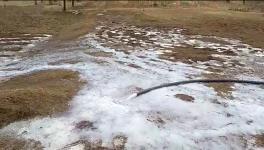New Findings Show Way to Better Manage and Prevent Uranium Contamination in Groundwater
Anthropogenic factors have not only affected the climate but have also adversely impacted the groundwater. Overexploitation of groundwater has resulted in a massive depletion, which has become a major concern across the world. India is facing the danger of groundwater depletion while human activities have also contaminated groundwater.
Groundwater in India suffers contamination from multiple elements, the common ones being arsenic and fluoride. But recent trends have rang a warning bell. Groundwater is now being found with the presence of uranium in it. Studies have shown that presence of uranium in Indian groundwater may be considered as an emerging and widespread phenomenon. It was found that in Indian states like Rajasthan and Gujarat, prevalence of uranium is higher in concentration than the limit in the World Health Organization (WHO) guidelines, that is above 30 microgram per litre of water. Primary source of uranium is natural, but human activities like decline in groundwater table may have contributed to the mobilisation of the element in the groundwater.
Now, a latest research conducted at Stanford University has found the trigger that causes naturally occurring uranium to sip into groundwater from sediments. The study was published on December 8 in the journal Environmental Science and Technology.
In the study, the researchers combined aquifer information and soil properties to predict the groundwater quality and also pinpointed the factors associated with uranium contamination. It was found that calcium concentration and soil alkalinity are the determining factors in uranium concentration in groundwater. The study was conducted in the aquifers of the Central Valley of California. The focus area of the research was chosen considering the fact that the area has an excess of uranium in its groundwater beyond the 30 microgram per liter mark.
Commenting on the usability of their findings, Scott Fendorf, one of the authors of the research said—“Every aquifer has one or more of these natural contaminants. The question is whether they sit benignly in the sediments or really cause problems by getting into the groundwater. Water managers can use our findings to forecast solutions before the problems are manifested.”
The study considered the chemical impact of the process of groundwater recharge. This is done when rain water seeps into soil and moves downward and finally into the aquifers. Seeping of rainwater down the soil changes its chemistry as it has to interact with the ground environment. Now, when the settled water is pumped out (anthropogenic activity) again, it changes the dynamics of the aquifers and also changes how elements such as uranium are stored in a partition between solid (sediment) and water.
The research found that if water takes up more calcium in its journey, and become more alkaline, then it can attract the radioactive element uranium into the aquifers, and thus, contaminate it heavily.
Alandra Lopez, the lead author of the study commented—"Our work shows that it's not just properties of the aquifer that are impacting uranium, but factors such as clay content and pH of the soil that served as important predictors of groundwater uranium concentrations. It highlights the importance of including data about soil properties when generating aquifer vulnerability maps for a naturally occurring contaminant like uranium”.
The research also found that the factors causing uranium loosening from the sediments and coming to the groundwater primarily occur within the top six feet of the soil. This could prove beneficial in groundwater management. “If you're going to manage aquifer recharge, which will be increasingly needed with climate change, be careful about having the water infiltrate through the soil where calcium and alkalinity are often highest. These management scenarios are being considered right now. We're trying to tell everybody that you need to think about this ahead of time, because that's when you can manage around the problem. It's a kind of forward prediction versus hindsight reaction -- once you measure uranium in the water, your problem is already at hand and it's much more expensive to fix,” commented Fendorf.
Get the latest reports & analysis with people's perspective on Protests, movements & deep analytical videos, discussions of the current affairs in your Telegram app. Subscribe to NewsClick's Telegram channel & get Real-Time updates on stories, as they get published on our website.
















